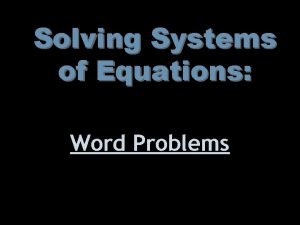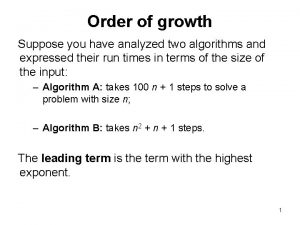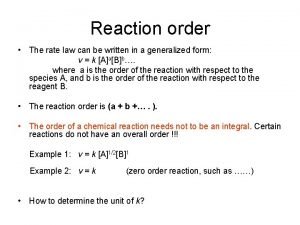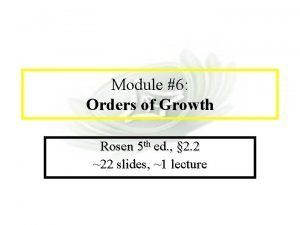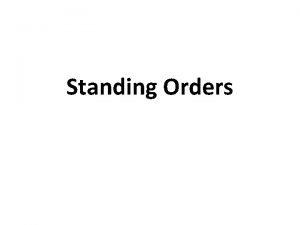Module 6 Orders of Growth Module 6 Orders























- Slides: 23

Module #6 – Orders of Growth Module #6: Orders of Growth Rosen 5 th ed. , § 2. 2 ~22 slides, ~1 lecture 2020 -10 -28 (c)2001 -2003, Michael P. Frank 1

Module #6 – Orders of Growth (§ 1. 8) • For functions over numbers, we often need to know a rough measure of how fast a function grows. • If f(x) is faster growing than g(x), then f(x) always eventually becomes larger than g(x) in the limit (for large enough values of x). • Useful in engineering for showing that one design scales better or worse than another. 2020 -10 -28 (c)2001 -2003, Michael P. Frank 2

Module #6 – Orders of Growth - Motivation • Suppose you are designing a web site to process user data (e. g. , financial records). • Suppose database program A takes f. A(n)=30 n+8 microseconds to process any n records, while program B takes f. B(n)=n 2+1 microseconds to process the n records. • Which program do you choose, knowing you’ll want to support millions of users? 2020 -10 -28 (c)2001 -2003, Michael P. Frank 3

Module #6 – Orders of Growth • On a graph, as you go to the right, a faster growing function eventually becomes larger. . . 2020 -10 -28 Value of function Visualizing Orders of Growth f. A(n)=30 n+8 f. B(n)=n 2+1 Increasing n (c)2001 -2003, Michael P. Frank 4

Module #6 – Orders of Growth Concept of order of growth • We say f. A(n)=30 n+8 is order n, or O(n). It is, at most, roughly proportional to n. • f. B(n)=n 2+1 is order n 2, or O(n 2). It is roughly proportional to n 2. • Any O(n 2) function is faster-growing than any O(n) function. • For large numbers of user records, the O(n 2) function will always take more time. 2020 -10 -28 (c)2001 -2003, Michael P. Frank 5

Module #6 – Orders of Growth Definition: O(g), at most order g Let g be any function R R. • Define “at most order g”, written O(g), to be: {f: R R | c, k: x>k: f(x) cg(x)}. – “Beyond some point k, function f is at most a constant c times g (i. e. , proportional to g). ” • “f is at most order g”, or “f is O(g)”, or “f=O(g)” all just mean that f O(g). • Sometimes the phrase “at most” is omitted. 2020 -10 -28 (c)2001 -2003, Michael P. Frank 6

Module #6 – Orders of Growth Points about the definition • Note that f is O(g) so long as any values of c and k exist that satisfy the definition. • But: The particular c, k, values that make the statement true are not unique: Any larger value of c and/or k will also work. • You are not required to find the smallest c and k values that work. (Indeed, in some cases, there may be no smallest values!) 2020 -10 -28 However, you should prove that the values you choose do work. 7 (c)2001 -2003, Michael P. Frank

Module #6 – Orders of Growth “Big-O” Proof Examples • Show that 30 n+8 is O(n). – Show c, k: n>k: 30 n+8 cn. • Let c=31, k=8. Assume n>k=8. Then cn = 31 n = 30 n + n > 30 n+8, so 30 n+8 < cn. • Show that n 2+1 is O(n 2). – Show c, k: n>k: n 2+1 cn 2. • Let c=2, k=1. Assume n>1. Then cn 2 = 2 n 2 = n 2+n 2 > n 2+1, or n 2+1< cn 2. 2020 -10 -28 (c)2001 -2003, Michael P. Frank 8

Module #6 – Orders of Growth • Note 30 n+8 isn’t less than n anywhere (n>0). • It isn’t even less than 31 n everywhere. • But it is less than 31 n everywhere to the right of n=8. 2020 -10 -28 Value of function Big-O example, graphically cn = 31 n 30 n+8 O(n) n>k=8 Increasing n (c)2001 -2003, Michael P. Frank 9

Module #6 – Orders of Growth Useful Facts about Big O • Big O, as a relation, is transitive: f O(g) g O(h) f O(h) • O with constant multiples, roots, and logs. . . f (in (1)) & constants a, b R, with b 0, af, f 1 -b, and (logb f)a are all O(f). • Sums of functions: If g O(f) and h O(f), then g+h O(f). 2020 -10 -28 (c)2001 -2003, Michael P. Frank 10

Module #6 – Orders of Growth More Big-O facts • c>0, O(cf)=O(f+c)=O(f) • f 1 O(g 1) f 2 O(g 2) – f 1 f 2 O(g 1 g 2) – f 1+f 2 O(g 1+g 2) = O(max(g 1, g 2)) = O(g 1) if g 2 O(g 1) 2020 -10 -28 (c)2001 -2003, Michael P. Frank (Very useful!) 11

Module #6 – Orders of Growth (§ 1. 8) - So Far • For any g: R R, “at most order g”, O(g) {f: R R | c, k x>k |f(x)| |cg(x)|}. – Often, one deals only with positive functions and can ignore absolute value symbols. • “f O(g)” often written “f is O(g)” or “f=O(g)”. – The latter form is an instance of a more general convention. . . 2020 -10 -28 (c)2001 -2003, Michael P. Frank 12

Module #6 – Orders of Growth Order-of-Growth Expressions • “O(f)” when used as a term in an arithmetic expression means: “some function f such that f O(f)”. • E. g. : “x 2+O(x)” means “x 2 plus some function that is O(x)”. • Formally, you can think of any such expression as denoting a set of functions: “x 2+O(x)” : {g | f O(x): g(x)= x 2+f(x)} 2020 -10 -28 (c)2001 -2003, Michael P. Frank 13

Module #6 – Orders of Growth Order of Growth Equations • Suppose E 1 and E 2 are order-of-growth expressions corresponding to the sets of functions S and T, respectively. • Then the “equation” E 1=E 2 really means f S, g T : f=g or simply S T. • Example: x 2 + O(x) = O(x 2) means f O(x): g O(x 2): x 2+f(x)=g(x) 2020 -10 -28 (c)2001 -2003, Michael P. Frank 14

Module #6 – Orders of Growth Useful Facts about Big O • f, g & constants a, b R, with b 0, – af = O(f); – f+O(f) = O(f); (e. g. 3 x 2 = O(x 2)) (e. g. x 2+x = O(x 2)) • Also, if f= (1) (at least order 1), then: 2020 -10 -28 – |f|1 -b = O(f); (e. g. x 1 = O(x)) – (logb |f|)a = O(f). (e. g. log x = O(x)) – g=O(fg) (e. g. x = O(x log x)) – fg O(g) (e. g. x log x O(x)) – a=O(f) (e. g. 3 = O(x)) (c)2001 -2003, Michael P. Frank 15

Module #6 – Orders of Growth Definition: (g), exactly order g • If f O(g) and g O(f) then we say “g and f are of the same order” or “f is (exactly) order g” and write f (g). • Another equivalent definition: (g) {f: R R | c 1 c 2 k x>k: |c 1 g(x)| |f(x)| |c 2 g(x)| } • “Everywhere beyond some point k, f(x) lies in between two multiples of g(x). ” 2020 -10 -28 (c)2001 -2003, Michael P. Frank 16

Module #6 – Orders of Growth Rules for • Mostly like rules for O( ), except: • f, g>0 & constants a, b R, with b>0, af (f), but Same as with O. f (fg) unless g= (1) Unlike O. |f| 1 -b (f), and Unlike with O. (logb |f|)c (f). Unlike with O. • The functions in the latter two cases we say are strictly of lower order than (f). 2020 -10 -28 (c)2001 -2003, Michael P. Frank 17

Module #6 – Orders of Growth example • Determine whether: • Quick solution: 2020 -10 -28 (c)2001 -2003, Michael P. Frank 18

Module #6 – Orders of Growth Other Order-of-Growth Relations • (g) = {f | g O(f)} “The functions that are at least order g. ” • o(g) = {f | c>0 k x>k : |f(x)| < |cg(x)|} “The functions that are strictly lower order than g. ” o(g) O(g) (g). • (g) = {f | c>0 k x>k : |cg(x)| < |f(x)|} “The functions that are strictly higher order than g. ” (g). 2020 -10 -28 (c)2001 -2003, Michael P. Frank 19

Module #6 – Orders of Growth Relations Between the Relations • Subset relations between order-of-growth sets. R R ( f ) O( f ) • f o( f ) 2020 -10 -28 ( f ) (c)2001 -2003, Michael P. Frank 20

Module #6 – Orders of Growth Why o(f) O(x) • A function that is O(x), but neither o(x) nor (x): 2020 -10 -28 (c)2001 -2003, Michael P. Frank 21

Module #6 – Orders of Growth Strict Ordering of Functions • Temporarily let’s write f g to mean f o(g), f~g to mean f (g) • Note that • Let k>1. Then the following are true: 1 log n ~ logk n n 1/k n n log n nk kn n! nn … 2020 -10 -28 (c)2001 -2003, Michael P. Frank 22

Module #6 – Orders of Growth Review: Orders of Growth (§ 1. 8) Definitions of order-of-growth sets, g: R R • O(g) {f | c>0 k x>k |f(x)| < |cg(x)|} • o(g) {f | c>0 k x>k |f(x)| < |cg(x)|} • (g) {f | g O(f)} • (g) {f | g o(f)} • (g) O(g) 2020 -10 -28 (c)2001 -2003, Michael P. Frank 23
 Casey orders 3 pizzas
Casey orders 3 pizzas Casey orders 3 pizzas
Casey orders 3 pizzas Casey orders 3 pizzas and 2 orders of breadsticks
Casey orders 3 pizzas and 2 orders of breadsticks Orders of growth
Orders of growth Primary growth and secondary growth in plants
Primary growth and secondary growth in plants Organic vs inorganic growth
Organic vs inorganic growth Growth is defined as an increase in
Growth is defined as an increase in Primary growth and secondary growth in plants
Primary growth and secondary growth in plants Pith
Pith Geometric growth population
Geometric growth population Step growth polymerization vs chain growth
Step growth polymerization vs chain growth Neoclassical growth theory vs. endogenous growth theory
Neoclassical growth theory vs. endogenous growth theory C device module module 1
C device module module 1 Sacrament of holy orders symbols
Sacrament of holy orders symbols Chapter 6 holy orders study questions
Chapter 6 holy orders study questions President formal and informal powers
President formal and informal powers What are the rules for writing scientific names
What are the rules for writing scientific names Rate law orders
Rate law orders Select * from orders
Select * from orders Marine mammal orders
Marine mammal orders Admit orders
Admit orders Consummate
Consummate Trophy images
Trophy images Social forces states and world orders
Social forces states and world orders


